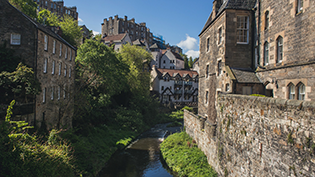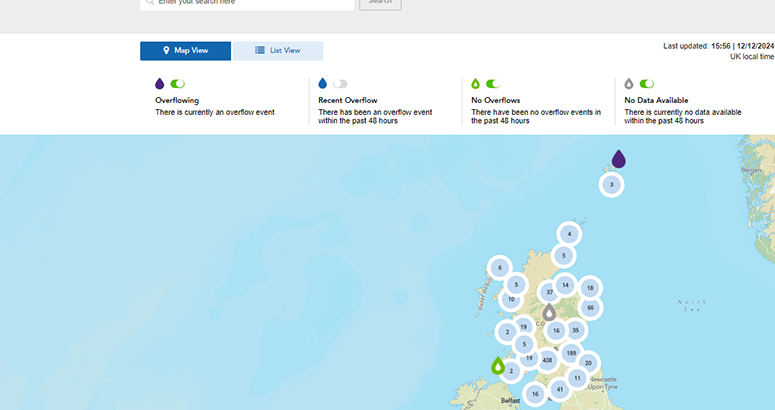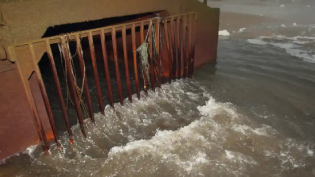Overflow FAQs
Overflows Explained:
One of the most important things we do is protect public health by removing waste water from homes, businesses, and communities to be treated and returned safely to the environment.
Waste water can include waste from toilets, sinks, baths, showers, rainwater from roofs and gardens, as well as surface water from roads and gullies.
Most of our sewer pipes are ‘combined sewers’. This is usually one single pipe that combines waste water from our homes and businesses and surface water from the wider environment.
Overflow FAQs
They operate automatically as a relief system during heavy rain or storm conditions, or if sewers are overwhelmed due to blockages.
If the sewer network, pumping station, or treatment facility becomes overwhelmed, the overflow is triggered to take the excess storm water and release it into our waterways.
A very small amount of waste water can get mixed into the storm water, but it is significantly diluted.
When rainfall subsides and levels return to normal, the overflows stop automatically.
Overflows are permitted to discharge into the environment subject to conditions set by the Scottish Environment Protection Agency (SEPA).
During heavy rainfall, we have to protect our customers and their homes and businesses from sewer flooding so this overflow ‘release’ system is vital.
Of course, we'd love it if we didn't need them, but without overflows the sewer network would back up, flooding homes, businesses, roads and open spaces with diluted sewage and rainwater, from manholes, road run-off and drains.
Usually, this only happens when there’s been a heavy rain downpour or prolonged wet weather, or if there has been a blockage or damage to the sewer network, so any water that is released into waterbodies is unlikely to cause environmental impact.
We can't dig up entire communities to replace our combined sewer network. But we can change the future. For example, for new developments, it's now part of the planning process to ensure measures, such as blue-green infrastructure (nature based solutions) are built into designs to deal with surface water so it doesn't enter the sewer network at all.
Storm overflows are intended to operate only in response to extreme weather conditions, when the sewer network is overwhelmed by the volume of rainfall.
They should operate in accordance with the licence conditions issued by the Scottish Environment Protection Agency (SEPA), which specify the conditions that need to be met before an overflow event is allowed.
Storm overflows may also operate if there are blockages or sewer network issues, such as a sewer collapse, that prevent the normal flow of waste water to the treatment plants.
Some overflows cover a very large geographical area which means there could be a delay from when the rainwater enters the network to when it enters the waterbody. Sometimes this can take a few days.
Emergency overflows should not operate in response to rainfall. They may operate in wet or dry weather if there is a sewer system failure, such as electrical, mechanical, power failure and/or blockages and should operate as per SEPA licence conditions.
More than one overflow may be connected to an outfall pipe and outfalls can be some distance away from an overflow location.
If the overflows on the Scottish Water waste water network are working normally, and there has been recent rainfall, it's likely that they are working as they're designed to, and there should be no impact on the water environment.
However, it's important to know there are a number of other factors which could impact the water environment:
- Agricultural run-off from farmland
- Discharges from private systems such as septic tanks and overflows
- Road run off from surrounding roads and highway drainage systems
- Waste pipes from houses wrongly connected into surface water sewers or culverts
- Domestic animal waste, such as dogs, farming livestock, wild animals and birds
- Human behaviour, due to items wrongly disposed of down sinks and toilets
We have licences for sewers to overflow during heavy rainfall via environmental licences from our environmental regulator, Scottish Environment Protection Agency (SEPA). All discharges into waterbodies must comply with conditions set in these licences.
The levels of untreated sewage in waste water from our network mixed with surface water is very dilute - less than 1 per cent - so it's unlikely to cause harm to the environment. The vast majority of our waste water is actually 'grey' water from sinks, showers, baths, washing machines or dishwashers and other appliances in homes and businesses.
SEPA monitors and takes samples from the waterbodies to understand if there is any impact on the environment.
What can impact the environment from overflows is sewage related debris (SRD) - items that have wrongly been flushed down the toilet - mixed in with the surface water.
Items commonly flushed down the toilet are wet wipes, cotton buds, and female sanitary products. Items commonly put down drains are fats, oils and grease. These can make their way into rivers, burns, and coastal waters from overflows.
But this is easily preventable and you can play your part.
- Bin the wipes - never flush them. You can read more about our Nature Calls campaign
- Only ever flush the 3Ps (pee, poo, and toilet paper). More advice here: Scottish Water Cycle
Studies have been undertaken to prioritise unsatisfactory sewer overflows for phased improvement, further information on investment prioritisation can be found at Prioritisation of Sewer Overflows in Scotland
It's important to know that this map, and the data it contains, do not advise if it's safe to swim or enter the water. This is not water quality data.
For the latest information on bathing water quality visit: Bathing Waters | Home | Scottish Environment Protection Agency (SEPA)
An overflow operating as designed should not cause environmental harm.
Our near real-time map data only indicates if a monitor has been activated and for how long the overflow may have operated. It does not confirm an overflow event has occured. The monitors are sensitive and may have been activated by several other factors, such as moving vegetation.
Our published data does not include the potential impact of each overflow event and Scottish Water is not liable for your interpretation of the information provided.
There are a number of other sources that could impact water quality and safety of our waterbodies, and these can vary depending on the surrounding area.
Here are some of the main factors which should be considered in your assessment of water quality:
- Agricultural run-off from farmland
- Waste water from private systems such as septic tanks and overflows
- Road run off from surrounding roads and highway drainage systems
- Waste pipes from houses wrongly connected into surface water sewers or culverts
- Domestic animal waste, such as dogs, farming livestock, wild animals and birds
- Human behaviour, due to items wrongly disposed of down sinks and toilets, littering and not picking up dog poo
Typically, during overflow events, around 99% of the storm water is surface water from roads and roofs, along with 'grey' water – waste water from household or business appliances, sinks and showers. Only a very small amount (about 1%) comes from toilets. This means that any waste water released into our waterbodies is very diluted.
Overflows are licenced to operate with conditions set to protect the environment.
Where we identify improvements are required, these are prioritised for investment as agreed with our regulator, the Scottish Environment Protection Agency (SEPA).
Around 87% of Scotland’s waterbodies achieve at least ‘good condition’ according to the Water Framework Directive classification – the highest level since the first classification in 2009. That's a great starting point, compared to England and Wales.
The River Basin Management Plan (RBMP) for Scotland 2021 - 2027 sets out the steps we will take to further protect and improve our water environment.
And in 2021 Scottish Water published its Improving Urban Waters Routemap with annual updates further underlining our commitment for the improvement of urban waters.
It sets out a programme of continued action to reduce waste water pollution and sewage litter over the coming decade backed by investment of half a billion pounds in the waste water system, including treatment works and overflows, to improve the quality of waste water overflow events and protect our waterbodies.
We are committed to improving water quality; increasing monitoring and publication of our overflow data; reducing sewer related debris in the environment; and reducing overflow events from the waste water network.
Our programme to install 1000 new monitors on high priority overflow sites by the end of 2024 to provide near real-time data on overflow events has been completed and we aim to increase this to a total of 2000 monitored sites by the end of 2025, rising to 3000 by the end of 2026. Technology will also be fitted upstream in some areas to reduce the risk of overflow events.
Where studies confirm there is a need for improvement, we will agree priorities with our environmental regulator, the Scottish Environment Protection Agency (SEPA). More information is available at Prioritisation of Sewer Overflows in Scotland.
As part of our improved monitoring and publication process you can find our published data on the Published Overflow Data page and access near real-time information on our Overflow Map.
Scottish Water is publicly owned, so it really is owned by you.
That means everyone can play their part in improving how our sewer network operates by ensuring we don't put inappropriate items down our toilets, sinks, and drains.
- Our Nature Calls campaign calls for customers to bin the wipes and we have called for a ban on plastic in wipes
- Customers should only flush the 3Ps down the toilet – pee, poo, and (toilet) paper
- Avoid disposing of fats, oils, and grease (FOGs) down sinks and drains as these can cause fatbergs to form in the wastewater network
We attend around 36,000 blockages a year, at a cost of £7 million. More than 80 percent are caused by the wrong things being flushed down the toilet, such as wet wipes, cotton buds, and period items.
We have lots of other advice to use and dispose of water wisely, in the kitchen, the garden, and bathroom. Keep paving to a minimum at your property to allow runoff from driveways to drain into green spaces. Visit Save Water.
There are many different factors that have the potential to affect the water quality and safety of our rivers and coastal waters, and these can vary depending on the surrounding area.
Here are just some of the things that could have an impact on water quality either in rivers or coastal waters:
- Agricultural run-off from farmland
- Discharges from private systems such as septic tanks and overflows
- Road runoff from surrounding roads and highway drainage systems
- Waste pipes from houses wrongly connected to surface water sewers or culverts
- Domestic animal waste, such as dogs, farming livestock, wild animals, and birds
- Human behaviour, due to items wrongly flushed down the toilet, sinks and drains, littering, and not picking up dog poo
Not all outfalls or overflow events to waterbodies are from Scottish Water waste water overflows. Many others are out with our control.
Other examples that can impact the environment include:
- Surface water outfalls – surface water from roads and roofs
- Waste water pipes wrongly connected to surface water systems or waste put down surface water drains
- Treated waste water from treatment works – which should be in accordance with SEPA licence requirements
- Other outfalls and overflows from private systems
- Culverted watercourses – a watercourse that has been channelled through a pipe so it can be built over
We have an agreed process for reporting and dealing with Environmental Pollution Incidents (EPIs) with our environmental regulator, the Scottish Environment Protection Agency (SEPA).
Overflows are designed to operate during periods of heavy rainfall, to prevent flooding to homes and streets. It's mainly surface water that is overflowing. If it's operating normally, there shouldn't be any environmental impact on the waterbody.
If you see an 'Overflowing' status on our interactive near real-time map, you don't need to report this to us. We capture data continuously and have processes in place to review, investigate, and respond where appropriate.
If there has been recent heavy rainfall, it's likely the overflow is operating as it's designed to do and you don't need to report it to us.
It's important to note that excess storm water can take some time to make its way through the network to the actual outfall and into a waterbody.
If you think you see a pollution issue at an outfall or overflow, such as:
- It might be overflowing in dry weather
- Sewage-related debris (SRD) is visible
- Pollution is present in the water
You can report this to Scottish Water via our Report a Problem portal. Please choose the Waste Water option and then Pollution option and follow the prompts. The issue will then be investigated as soon as possible.









